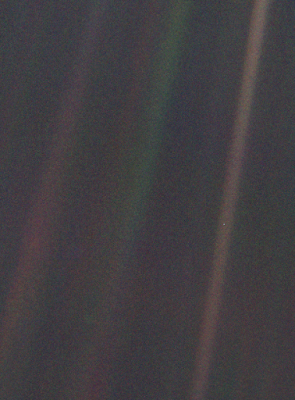We're currently reading, among other works, Carl Sagan's Pale Blue Dot, A Vision of the Human Future in Space. We're only as far as "Chapter 4, A Universe Not Made For Us." That's where Sagan makes reference to ethnocentrism among primates.
To whichever little group we happen to be born, we owe passionate love and loyalty. Members of other groups are beneath contempt, deserving of rejection and hostility. That both groups are of the same species, that to an outside observer they are virtually indistinguishable, makes no difference. This is certainly the pattern among chimpanzees, our closest relatives in the animal kingdom. Ann Druyan and I have described how this way of viewing the world may have made enormous evolutionary sense a few million years ago, however dangerous it has become today. Even members of hunter-gatherer groups--as far from the technological feats of our present global civilization as it is possible for humans to be-- solumnly describe their little band, whichever it is, as "the people." Everyone else is something different, something less than human.
I've read enough about Native American cosmology to wonder if "something less than human" is a legitimate rephrasing of the perspective of at least some Native Americans. Robin Kimmerer, a citizen of the Potawatomi nation, in her book, Braiding Sweetgrass, writes "But in Native ways of knowing, human people are often referred to as 'the younger brothers of Creation.' We say that humans have the least experience with how to live and thus the most to learn--we must look to our teachers among the other species for guidance." That reads to me as something very different than what Sagan wrote, unless he was only referring to "other humans" as "something less than human." A further complication arises from Kimmerer's description of her indigenous language as being entirely different, and based differently, then English.
During our life, we've seen more evidence of the accuracy of most of Sagan's description, but we've also seen a growing awareness of and interest in what Kimmerer writes about. (Braiding Sweetgrass is one of the best books we've ever read.) So, if we follow Sagan's premises, we may be more accurate, but if we accept Kimmerer's perspective, we have more reason to hope.
 |
| this is our only home, a pale blue dot |
We ended up in this situation because some time ago we read a quotation from Sagan's The Demon-Haunted World, which seems to fit today's world only too well. We hadn't read Sagan's work earlier.
I have a foreboding of an America in my children's or grandchildren's time -- when the United States is a service and information economy; when nearly all the manufacturing industries have slipped away to other countries; when awesome technological powers are in the hands of a very few, and no one representing the public interest can even grasp the issues; when the people have lost the ability to set their own agendas or knowledgeably question those in authority; when, clutching our crystals and nervously consulting our horoscopes, our critical faculties in decline, unable to distinguish between what feels good and what's true, we slide, almost without noticing, back into superstition and darkness...
The dumbing down of American is most evident in the slow decay of substantive content in the enormously influential media, the 30 second sound bites (now down to 10 seconds or less), lowest common denominator programming, credulous presentations on pseudoscience and superstition, but especially a kind of celebration of ignorance.
Fortunately, Sagan also writes that “Avoidable human misery is more often caused not so much by stupidity as by ignorance, particularly our ignorance about ourselves.” I think that's where Braiding Sweetgrass comes in.
Repairing the Hubble Telescope
"Organizers Abruptly Cancel 25"' Anniversary Gala Honoring NASA's
Hubble Telescope As Riots Burn Through Baltimore"
The camera is having troublefocusing. A blurry spotwhere the universe is.Outside, a storm is brewing,trashcans into windshields.Outside agitators, a nebulaof thick dust. The imagesare black and white but you can imaginethe green of this star's birthas its extra spirals out.This spring a cosmic miragewhere you could watch, on every television,the death of a star in a supernova explosionnine billion years ago across the cosmos.Here in Sandtown, six menhave broken the spine of another.It was a mistaketo send the camera out so quickly.Easy to fix the lensbut nearly impossible to reach it,as far out from us as it has drifted already.
********************************************
Thanks for visiting. Come again when you can.
Please be kind to each other while you can.
No comments:
Post a Comment